Experts Reveal All The Facts About Fingerling Potatoes
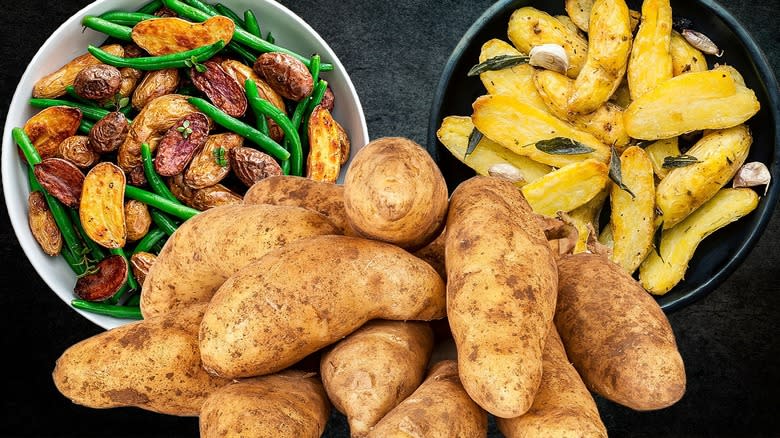
Potatoes come in all shapes and sizes, from huge baking potatoes to petite new potatoes. Ask one hundred people their favorite types and you're sure to get a lot of different answers — but we bet that fingerling potatoes are up there with the best-loved. With their small size and elongated shape, they're easy to tell apart from other types. It's not just that they look different, as they also have a distinctive taste that's part of what makes them a big hit for so many.
But, how much do you really know about fingerling potatoes? You might have cooked with them a bunch. They may even be among your favorites, but we'd put money on it that there are still things you don't know about them. So, we interviewed two cooking experts who love fingerlings to answer all the questions you've been pondering — and some you didn't even know to ask.
From cooking methods and varieties to info about flavors and textures, our experts reveal all the facts about fingerling potatoes. Not only will you learn some interesting new things about this type of spud, but you might discover some new ways to cook and enjoy these tasty tubers.
Read more: 16 Little-Known Facts About Salt
Fingerling Potatoes Come In A Range Of Colors
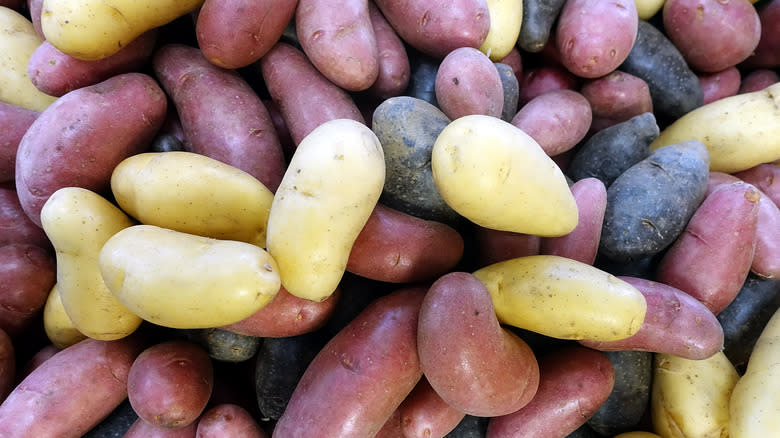
You're probably aware of standard white fingering potatoes. These are the most commonly found and what many people think of when they picture this variety. But, did you know that fingerlings come in various hues? This can add some color to your plate, making otherwise drab meals look gorgeous. Just pick up some bright fingerling potatoes and you'll instantly add some color without having to sacrifice any starchy goodness.
Some red fingerlings have red skins but regular white flesh inside while others have red skin and flesh. Yellow fingerlings have buttery yellow skin and flesh. It's only subtly different from white varieties, but you'll certainly notice when you cook the two alongside each other. Then you have purple fingerling potatoes, which have purple skin and flesh. While it's not unheard of in the potato world, it can be a surprise to anyone who hasn't encountered them before.
It's not just that these varieties look different; they can cook slightly differently, too. "Fingerling potatoes can still have quite a bit of variation," says recipe developer Jessie Johnson of food blog Life As A Strawberry. "If you buy a bag of multi-colored fingerling potatoes at the store and roast them all together, you may notice a slight difference in texture between, say, a purple fingerling potato and a red one." So, it might take a bit of experimentation to find your perfect potato for each dish.
There's No Need To Peel Fingerlings
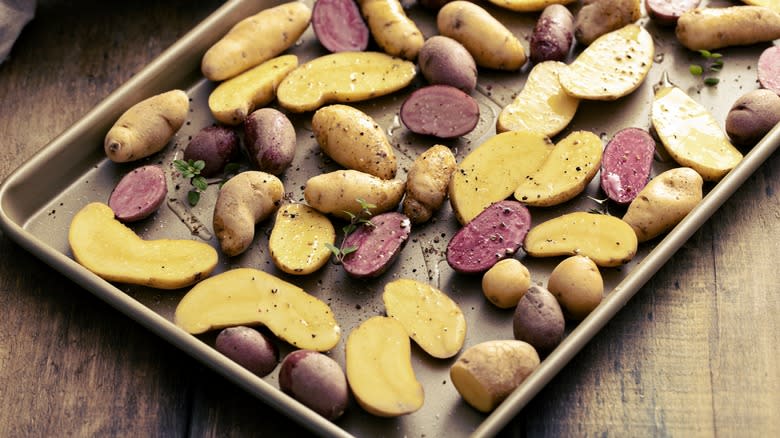
Peeling potatoes can be a real chore. And, when those potatoes are small, it's even more of a faff because it's more fiddly and there are a larger number to prepare. If you're already inwardly sighing about the idea of peeling a pile of fingerlings, we have some good news for you — they don't need to be peeled at all.
"One of the great things about fingerlings is one almost never needs to peel them," says Brian Theis, cookbook author and writer of food blog The Infinite Feast. "I frequently leave potatoes unpeeled — especially baby reds," he adds. The skin is thin enough that even people who usually don't like skin-on potatoes won't be likely to object. It may add a little texture, but nothing that you should detect as tough or overly fibrous.
Of course, this saves you time, but leaving the skin on has some other benefits, too. "If you like some texture in your mashed potatoes, use red or purple fingerlings for a gorgeous mash with bright pops of color from the potato skins," Johnson suggests. Yes, that's right — the idea that you can't leave the skin on is a mashed potato myth you need to stop believing. Plus, when you leave the skin on you get more antioxidants and fiber, making your potatoes even more nutritious.
They Have Waxy Flesh
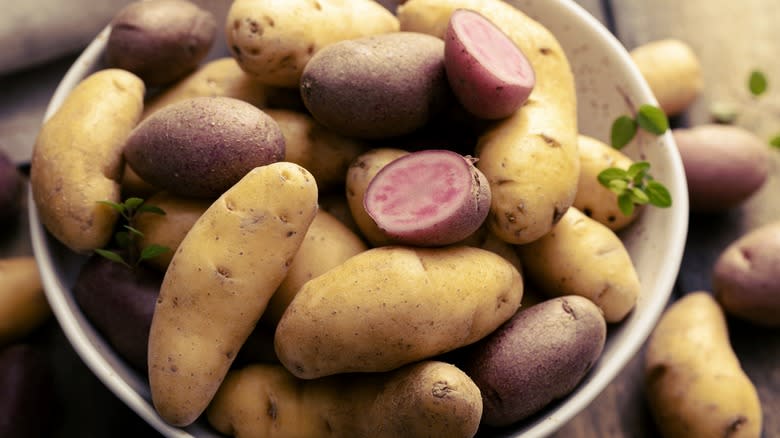
One thing you might not know about fingerling potatoes is that they always have waxy flesh. You might have heard of waxy versus starchy potatoes, but what does this mean exactly? Learning the difference between the two will help you decide when fingerlings are perfect for a recipe and when you might want a larger, more starchy variety.
"Fingerling potatoes tend to be more waxy than starchy, which means they hold their shape quite well after cooking," Johnson remarks. She says that this is different than "a starchy potato, like a russet, which will easily mash or crumble once cooked." Theis notes that, as a waxy potato, fingerlings contain more moisture than starchy potatoes. This means they "have more density because of this extra moisture and are excellent for any recipe that depends on potato slices that hold their shape, such as a gratin or a fancy potato salad."
Starchy potatoes on the other hand, have more starch and less moisture, hence why they are also known as floury potatoes. When cooked, this will give you an airier consistency that's great for baked potatoes and roast potatoes when you want a particularly fluffy interior. They're also a good choice for mashing and frying.
There Are Multiple Varieties Of Fingerling Potatoes
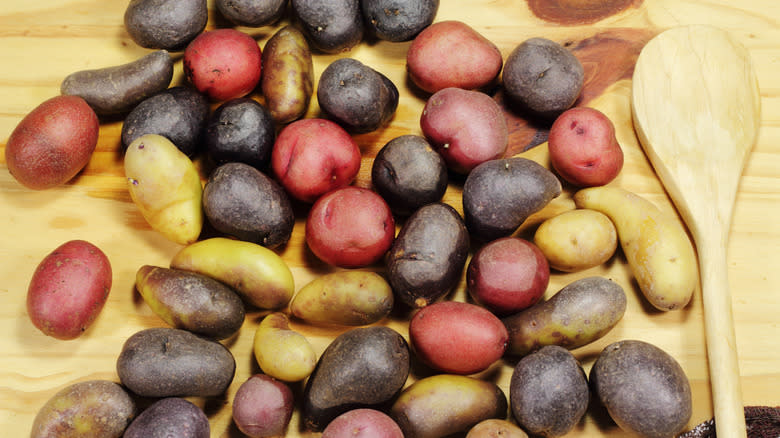
You might think that fingerling is a variety of potato, but it's more like a category that includes any small, elongated potato. It's an umbrella term for a range of varieties, the same way that a baking potato can be a vivaldi, Idaho, or russet. The truth is that there are many types of potatoes out there, and you might want to learn more about specific fingerling varieties.
The French fingerling is a common variety with pinky-red skin and yellow flesh. It's of a medium size and has a firm, waxy texture that great cooked whole and roasted. The Pink Fir Apple is another pink-skinned variety with a more knobbly texture and a notably nutty flavor.
If you want a more colorful variety, try the Purple Peruvian which, true to its name, has purple flesh and skin, as well as a slightly more starchy texture than most other fingerlings. You can maintain their purple color when boiling by adding a tablespoon of vinegar to the water. You could also opt for the red thumb variety, which has red skin and red flesh. It's slightly shorter than some fingerlings but has a nutty flavor and buttery texture that many prize.
Fingerling Potatoes Taste Slightly Different Than Other Varieties
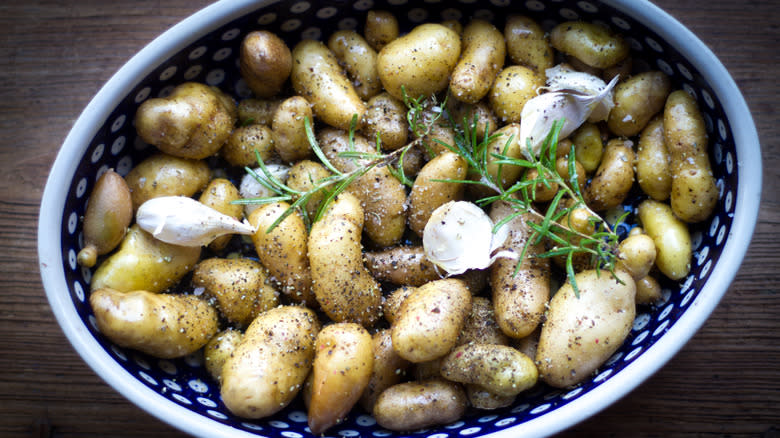
Wondering what all the fuss is about small potatoes? It might seem to many that they're just more fiddly to handle, but without any particular payoff. However, the fact is that fingerlings often taste slightly different than other potatoes. This in turn makes them worth seeking out and a favorite among those who love them.
"You could describe the flavor of fingerlings as slightly sweet and nutty compared to, say, a more neutral starchy russet, or a buttery Yukon Gold," Theis notes. However, he adds that fingerling varieties have their differences. For instance, "Russian Banana fingerlings can also have a delicious, buttery flavor."
"In my experience, fingerling potatoes can be a tiny bit sweeter than their full-size counterparts, with a slightly more pronounced earthy flavor," says Johnson. "But these differences are pretty minimal," she adds. Once strong flavors, such as spices, are added to a recipe, the average person might not notice a big difference between the taste of fingerlings and other potatoes. So, when you want to let their flavor shine, it's best to prepare them in fairly simple ways, such as boiled and served with butter or roasted with just salt and pepper.
They Get Crispier Than Other Potatoes
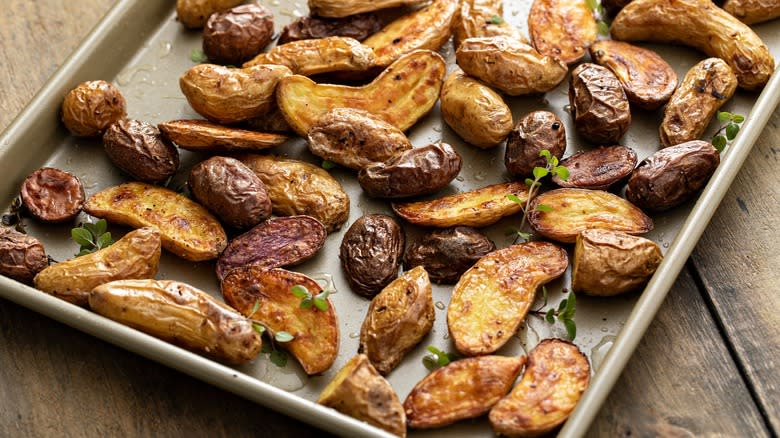
It might not be exactly accurate to say that fingerlings get crispier than all other potato varieties, but their makeup means that they seem crispier. Johnson prizes them for their crispy texture, which primarily comes from the skins. "Fingerling potatoes have a much higher ratio of skin to flesh," she says. "If you're roasting them, for example, you'll get more crispy potato skin in each bite with fingerling potatoes than with a larger potato you've cut into pieces." Crispy potato lovers, take note!
"I'm a fan of crispy, salty potato skins, so I love cooking fingerling potatoes in ways that highlight that amazing texture," Johnson says. Roasting and frying are amazing ways to make the most of how crispy they are. Parboiling potatoes before roasting or frying helps to make them crispy on the outside and soft on the inside. Fingerlings don't get as fluffy inside as starchy potatoes, but they shouldn't be overly dense or gluey.
Parboiling potatoes in advance and storing them in the fridge is a great way to cut down on your daily meal prep time, and is something Johnson does regularly. "When I'm ready to eat, I'll halve the pre-cooked potatoes and crisp them up in a hot pan with a bit of oil — it only takes a few minutes on each side to get them nice and browned," she says. You could also choose to roast these parboiled potatoes in a pan of hot oil.
Fingerlings Are Often Heirloom Potatoes
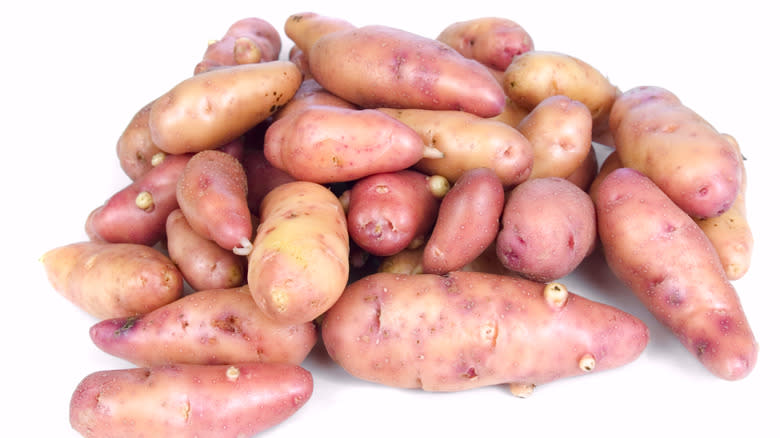
Although the term fingerling potato can refer to a number of varieties or cultivars, many of these types are heirloom ones. But, what does this mean, exactly? You've likely heard of heirloom vegetables. It's a phrase often used in the same breath as "farmers market" or "CSA." However, many people don't know what this means beyond the produce being fancier and more expensive.
Heirloom vegetables are older varieties of plants. These seeds are open-pollinated (meaning they're naturally pollinated by insects, birds, and other creatures) and have been passed down through the generations. There isn't a set length of time that a variety has to have been around to be classed as heirloom. Some consider anything pre-1950s to be part of the family, but many heirloom varieties have been around for well over 100 years.
These types of plants aren't just fancy, but are important for genetic diversity. Supermarkets and large producers often stick to growing the same types of crops, whether because of a high yield or ease of growing. This can lead to a lack of diversity, though it's worth noting that some heirloom varieties are more vulnerable to disease than hybrids. Still, choosing heirloom potatoes or choosing to grow them at home preserves these varieties for future generations. You can also be pretty sure that heirloom plants aren't genetically modified. What's more, some people simply claim they taste better. Be on the lookout for heirloom fingerlings like Ruby Crescent, Ozette Indian, and LaRatte.
You Can Cook Them In Many Ways
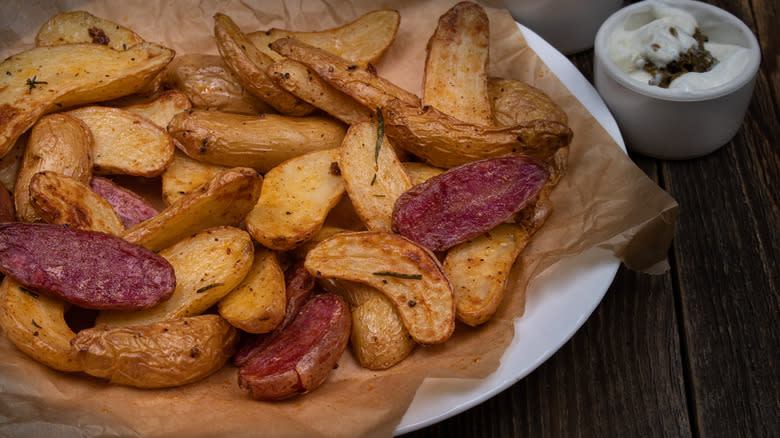
It's basically impossible to get bored of eating fingerling potatoes. "Fingerlings can be cooked in many ways, steamed, boiled, baked," says Theis, adding that they're very versatile. He particularly likes them in a salade Niçoise.
Johnson's go-to method is roasting — such as in this easy roasted fingerling potato recipe. "Halve any large fingerling potatoes so all the pieces are roughly the same size, toss with plenty of olive oil, salt, and whatever spices you like, and roast at high heat until crispy," she advises. "I usually flip the potatoes a few times during roasting so that all sides get nice and browned."
According to Johnson, you can use fingerlings in basically any recipe where you'd use another type of potato. She suggests that you "use fingerling potatoes for homemade hash browns, potato salad, or crispy smashed potatoes." They're especially good in recipes that call for waxy potatoes, though you can experiment and use them for anything. If you have any favorite comfort food potato recipes, they're great there, too. Another suggestion from Johnson — "If you have the time (and the patience!), turn fingerling potatoes into mini hasselback potatoes for a fun holiday appetizer."
You Should Store Them At Room Temperature — Not In The Fridge
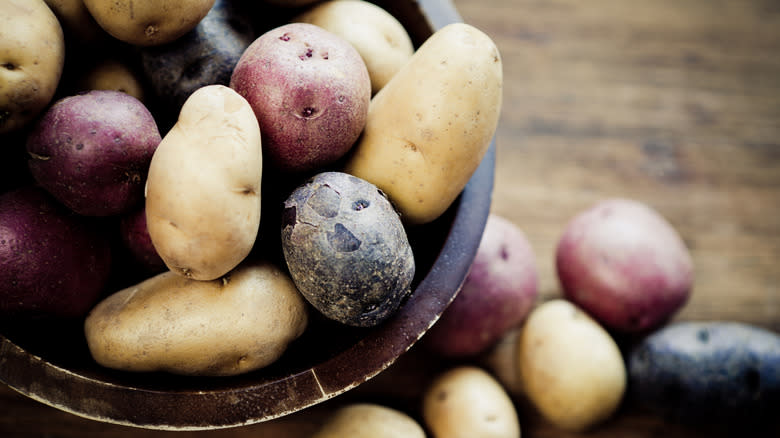
We store most vegetables in the fridge, so it makes sense to assume that potatoes are the same and that storing them in the fridge will make them last longer. Well, whether or not refrigeration makes fingerling potatoes last longer is irrelevant — you shouldn't do it because it affects the flavor.
When the temperature is too low, the starch in potatoes begins to turn to sugar and canmake them taste overly sweet. When you cook potatoes that have been stored in the fridge, these sugars combine with the amino acid asparagine, which is also found in spuds and can produce a chemical called acrylamide. This has been correlated with increased cancer risk but, as per the National Cancer Institute, no one's found a clear causal link. It's unlikely that this is going to cause any serious health issues, it's still best to avoid it just in case. Another more immediately obvious reason why you shouldn't store potatoes in the fridge is that it can also affect the texture, making them slightly gritty or mealy.
How to store fingerling potatoes instead? Ideally, potatoes should be stored between 45 and 50 degrees, but average room temperature is fine. Keep them in a cabinet or pantry, as sunlight can cause the spud to turn green. If they came in plastic, remove this, since it can cause moisture to build up and make potatoes spoil more quickly. An open basket, sack, or paper bag is better.
They're A Good Source Of Certain Vitamins
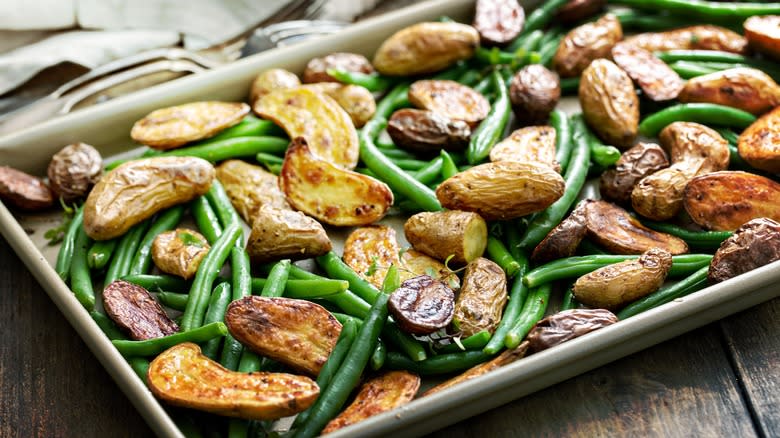
Many people think that fingerling potatoes are all starch without much nutritional value. But, while we wouldn't recommend living off potatoes alone, they contain enough vitamins and other nutrients that this would technically be possible, even if it wouldn't be the best choice for your health.
So, what vitamins can you find in fingerlings? Well, they're rich in B6, which plays a crucial role in brain health and mood regulation, as well as the production of red blood cells. They also contain a decent amount of vitamin C, which is essential for immune function and skin health. You'll also find reasonable quantities of folate — or vitamin B9 — in fingerlings with colored flesh.
Of course, they have nutritional benefits outside of vitamins. In 100 grams of fingerling potatoes, you'll find 1.8 grams of fiber. They also contain some potassium, iron, and calcium — though not in huge quantities. Fingerlings with colored skin and flesh contain higher levels of antioxidants than those without. All told, there's more nutritional benefit to fingerlings — and to potatoes in general — than you likely give them credit for. They're vegetables, after all, even if they are a starchy variety.
Fingerlings Resemble Ancient Wild Potatoes
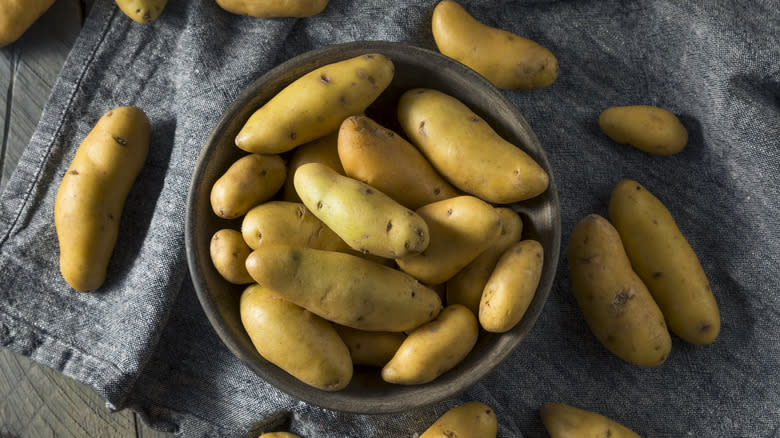
Fingerling potatoes are thinner than most potatoes, with an elongated shape. They resemble, well, fingers — hence the name. This might seem like an unusual shape for potatoes. It's different from the shape of the most common potato varieties today, but it's actually a similar shape to ancient wild potatoes.
Potatoes originated in the Andes, in an area that roughly equates to modern day Peru. They were first cultivated around 8,000 years ago, but it's likely that people in the area had foraged for wild potatoes for many years before this. Although wild potatoes can vary somewhat in shape and size, many are elongated and knobbly, a lot like fingerling potatoes.
However, this doesn't mean that fingerlings are any more closely related to wild potatoes than your average spud. It's more of a coincidence that they resemble them. That said, there are two heirloom varieties — Odette and Purple Peruvian — whose lineage can be traced all the way back to the Andes. Since they were first cultivated, potatoes have traveled around the globe and make up part of the cuisine of many countries as a filling staple that's easy to grow. Varieties grown today are bigger and tastier than wild versions, but there's still a reminder of their origins in the strange shape of fingerlings.
They're Fairly Disease-Resistant
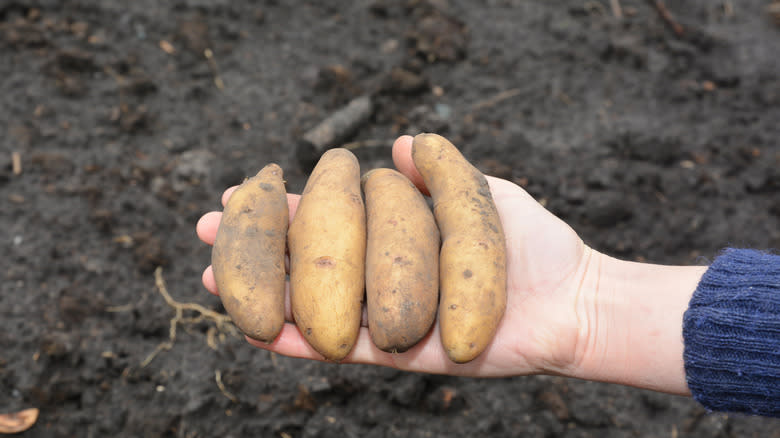
Yes, fingerling potatoes are great to cook with, but they're also easy to grow. One of the best reasons to grow them is their purported disease resistance though some sources state that they're not especially more resistant than larger varieties and benefit more from careful tending and checking for blight and other diseases.
Different varieties do seem to be somewhat hardier than others. The French Fingerling cultivar reportedly shows resistance to scab, leafhoppers, and potato beetles. They can also thrive in a range of soil types and under varied weather conditions, which is another reason why they're easy to grow and appealing to gardeners.
Whether you're new to growing potatoes or are well-versed in the practice, it's nice to have an option that's easy to grow. The prospect of a good level of disease resistance is hard to pass up as well. Plus, they taste great — what's not to love?
Read the original article on Mashed

 Yahoo Lifestyle
Yahoo Lifestyle 
